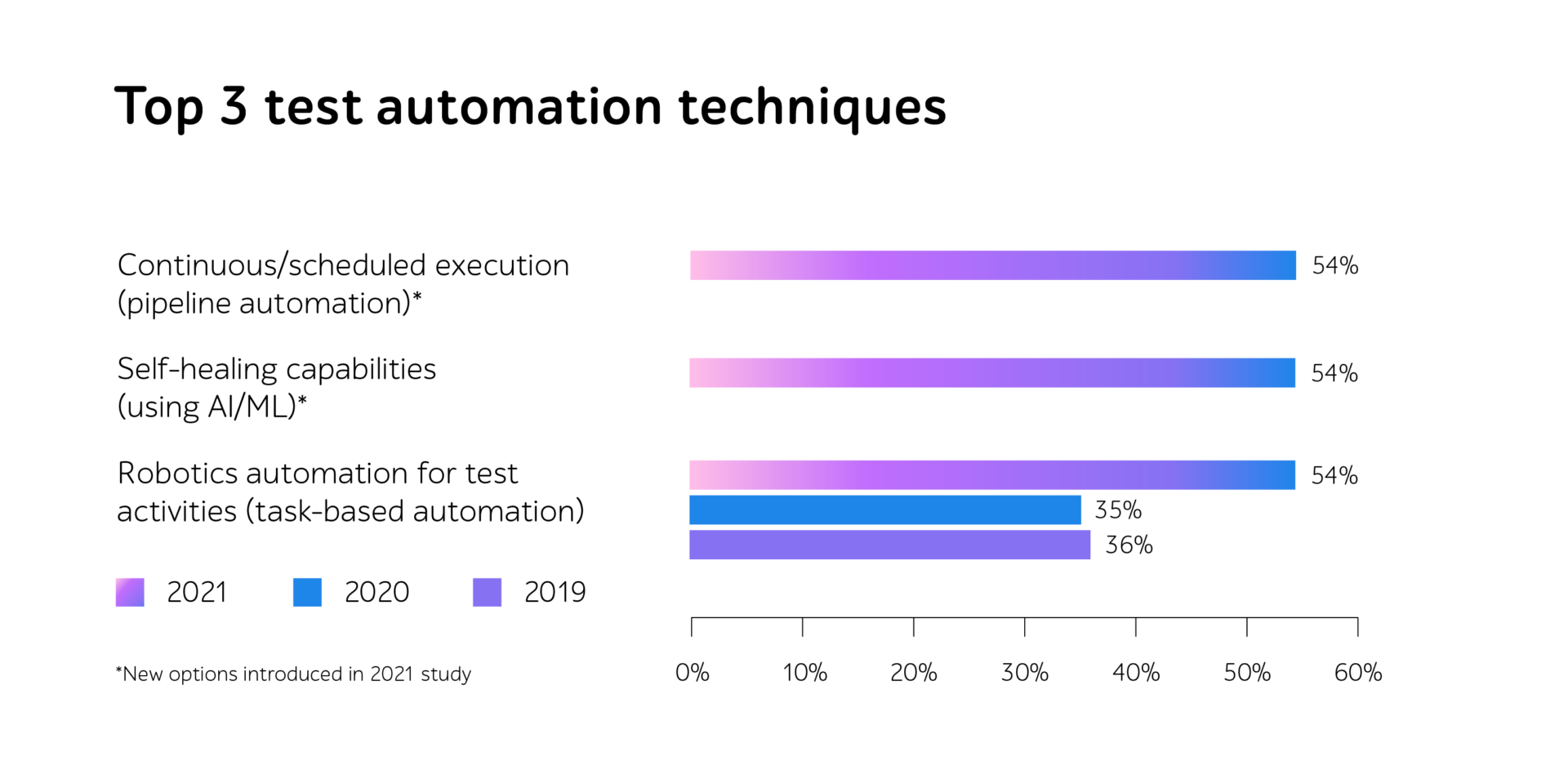
Stepping into the future: QA and software testing trends to thrive in 2022
The COVID-19 pandemic has expedited the adoption of digital technologies by many years. Forced to briskly switch businesses to online and continue operation against all odds, organizations had to introduce disruptive tech novelties — from AI and IoT to blockchain and augmented reality.
However, a digitization journey turned out to be challenging. According to BCG experts, 70% of high-scale transformations fail to reach their objectives. How can companies ensure overall process success and make their efforts pay off?
Among other things, they can place greater emphasis on QA. Focused on meeting quality gates and accelerating time to production, it helps attain bugless operation of secure and credible software.
To efficiently organize testing processes in 2022 and succeed in the “next normal” era, businesses can rely on 5 striking industry trends that we’ll highlight in the article:
- Keep adopting Agile and DevOps
- Attain digital transformation goals with quality engineering (QE)
- Rely on AI to obtain productive testing outcomes
- Automate intelligently to gain benefits faster
- Adapt test data and environment management to a global context.
Trend №1 – Keep adopting Agile and DevOps
To briskly respond to changing needs and deploy IT products with engaging CX, organizations stick to Agile and DevOps cultures oriented on delivering top-tier software with short notice through continuous quality improvement.
Despite the ongoing popularity of these approaches, World Quality Report 2021-22 (WQR) states that skill gap problems still prevail. For instance, one-third of 1,750 respondents experience the shortage of test environment, containerization, and test data skills. Whereas the other 44% of survey members marked the deficiency in the professional expertise of agile testing teams.
However, to optimize testing processes and simplify the way of implementing Agile and DevOps methodologies, companies can:
- Test software as early as possible (a shift-left approach)
- Automate more to deliver good-to-go code faster
- Optimize test cases with the help of AI
- Use automated dashboards to get a detailed view of quality.
To achieve maximum efficiency from the implemented approach, companies can put business priorities first and be more open-minding to adopt changes.
Trend №2 – Attain digital transformation (DT) goals with QE
Starting from 2020 and currently ongoing, the world is facing a boom in the speed of digital transformation journeys. Statista mentions that by 2025, the global spending on DT will reach almost $3 trillion! The trigger for its high demand is largely related to the COVID-19 pandemic, which has greatly expedited the DT velocity for about two-thirds of the interviewed (2,569 respondents in total).
However, the path to DT is intrinsically linked to implementing cutting-edge tech novelties like embedded software, blockchain, edge computing, and many others. To ensure high protection and efficiency of delivered IT solutions, companies rely on quality engineering.

Trend №3 – Rely on AI to obtain productive testing outcomes
AI implementation is gaining momentum globally. Experts highlight that by 2024, the worldwide AI market size will comprise more than $500 billion.
Finding its way into diverse industries, AI is already applied to deliver customer care services through chatbots, diagnose hazardous illnesses like sepsis, or even judge beauty contests.
WQR asserts that the QA industry also bears fruit from this technology, especially when it comes to a win-win tandem with test automation. Companies can apply it to create automated scripts as well as enhance their quality and reliability to improve time to market and increase the accuracy of a testing process by eliminating the human factor.
Other high-priority use cases of AI in software testing relate to predicting issues (42%), prioritizing tests (43%), and test environment provision (44%).
Trend №4 – Automate intelligently to gain benefits faster
For several years in a row, test automation has kept its leading positions amid the hottest QA services — experts state that by 2026, the global test automation market size will boom and comprise almost $50 billion.
Being the prime means of cutting delivery time, which is vital in the post-pandemic era, it enhances the quality of detecting defects, increases software security, and improves the testing process due to boosted transparency and monitoring of QA activities. ROI is another crucial benefit of its introduction. According to WQR, 50% of the interviewed IT representatives mentioned that their efforts are paying off.
Thus, it’s no secret that more organizations rely on automated QA workflows in their testing strategies. Which also has a hand in extending the pool of applied use cases, among which already today are continuous automation, self-healing, RPA, headless automation, scriptless approach, and many others.

However, to obtain the maximum value from the test automation approach, organizations should always stick to the essential rule in this scenario — striking balance, as 100% automation is an elusive and senseless objective.
Trend №5 – Adapt test data and environment management to a global context
Not only did the COVID-19 pandemic affect all the industries and expedite digital transformations, but it also forced employees to work from home.
It resulted in the continuous decrease in the usage of traditional environments and a shift towards cloud-based ones, which are now leveraged by 23% of the WQR respondents. Virtualized, containerized, and on-demand temporary test environments are also gaining momentum. And despite existing bumps in the road, for instance, the need to make sure cloud- and legacy-based apps are in sync, more than half of the survey participants are optimistic about the overall visibility of the existing environments.
What concerns test data management, the number of IT leaders who marked that their teams continuously meet data security and privacy regulations enlarged to 55%. Also, more respondents are copying production data rather than synthesizing test data because of the process-related challenges.
In a nutshell
Brisk adaptation to changing circumstances has become a critical priority for businesses striving to stay ahead of the competition in the “next normal.” For that, they may strengthen the quality of software products with QA and focus their efforts on testing in Agile and DevOps. Also, at the same time supporting digital transformations with quality engineering, using AI to boost QA efficiency, automating to expedite deployment to production, and improving test data and environment management.
Feel free to contact our experts to get professional QA support.








